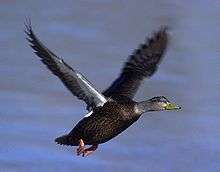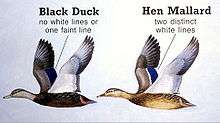American black duck
| American black duck | |
|---|---|
 | |
| American black duck in flight | |
| Scientific classification | |
| Kingdom: | Animalia |
| Phylum: | Chordata |
| Class: | Aves |
| Order: | Anseriformes |
| Family: | Anatidae |
| Subfamily: | Anatinae |
| Genus: | Anas |
| Species: | A. rubripes |
| Binomial name | |
| Anas rubripes (Brewster, 1902) | |
| Synonyms | |
|
Anas obscura | |
The American black duck (Anas rubripes) is a large dabbling duck. The scientific name is derived from Latin. Anas means "duck", and rubripes comes from ruber "red" and pes, "foot".[2] American black ducks are similar to mallards in size, and resemble the female mallard in coloration, although the black duck's plumage is darker. It is native to eastern North America and has shown reduction in numbers and increasing hybridization with the more common mallard as that species has spread with man-made habitat changes.
Description


American black ducks weigh 720–1,640 g (1.59–3.62 lb), measure 48–63 cm (19–25 in) in length and 88–96 cm (35–38 in) across the wings.[3] Although they are similar to mallards in size and broadly overlap in weight, according to a manual of avian body masses, they have the highest mean body mass in the Anas genus, with 376 males averaging 1.4 kg (3.1 lb) and 176 females averaging 1.1 kg (2.4 lb).[4][5] The American black duck somewhat resembles the female mallard in coloration, although the black duck's plumage is darker. The male and female black duck are generally similar in appearance, but the male's bill is yellow while the female's is a dull green. The head is slightly lighter brown than the dark brown body, and the speculums are iridescent violet-blue with predominantly black margins. The black duck has orange legs and dark eyes. In flight, the white underwings can be seen in contrast to the dark brown body. The behaviour and voice are the same as for the mallard drake.[6]
Breeding

Their breeding habitat is alkaline marshes, acid bogs, lakes, ponds, rivers, marshes, brackish marshes, and the margins of estuaries and other aquatic environments in northern Saskatchewan, Manitoba, across Ontario and Quebec as well as the Atlantic Canadian Provinces, including the Great Lakes, and the Adirondacks in the United States. Female black ducks lay an average of 9 eggs.[6]
Black ducks interbreed regularly and extensively with mallard ducks,[7] to which they are closely related. Some authorities even consider the black duck to be a subspecies of the mallard, not a separate species at all. Mank et al. argue that this is in error as the extent of hybridization alone is not a valid means to delimitate Anas species.[8]
In the past, it has been proposed that black ducks and mallards were formerly separated by habitat preference, with the black ducks’ dark plumage giving them a selective advantage in shaded forest pools in eastern North America, and the mallards’ lighter plumage giving an advantage in the brighter, more open prairie and plains lakes. In recent times, according to this view, deforestation in the east, and tree planting on the plains, has broken down this habitat separation, leading to the high levels of hybridization now observed.[9] However, rates of past hybridization are unknown in this and most other avian hybrid zones, and it is merely presumed in the case of the American black duck that past hybridization rates were lower than those seen today. Also, many avian hybrid zones are known to be stable and longstanding despite the occurrence of extensive interbreeding.[7] American black ducks and local mallards are now very hard to distinguish by means of microsatellite comparisons, even if many specimens are sampled [10] Contrary to this study's claims, the question whether the American haplotypes are an original mallard lineage is far from resolved. Their statement, "[N]orthern black ducks are now no more distinct from mallards than their southern conspecifics" of course only holds true in regard to the molecular markers tested. As birds indistinguishable according to the set of microsatellite markers still can look different, there are other genetic differences that were simply not tested in the study.[8]
The hybrids cannot be readily distinguished in the field and consequently, much of the species' hybridization dynamics remains unknown. It has been revealed in captivity studies, however, most of the hybrids don’t follow Haldane's Rule, but sometimes hybrid females die before they reach sexual maturity [7][11] this underscores the case for the American black duck being a distinct species.
This species is partially migratory and many winter in the east-central United States, especially coastal areas; some remain year-round in the Great Lakes region. These birds feed by dabbling in shallow water, and grazing on land. They mainly eat plants, but also some mollusks and aquatic insects. The eggs are a greenish buff color. They lay from 6–14 eggs, and hatch in an average of 30 days.
This duck is a rare vagrant to Great Britain and Ireland, where, over the years, several birds have settled in and bred with the local mallards. The resulting hybrids can present considerable identification difficulties.

Status
The black duck has long been valued as a game bird, being extremely wary and fast on the wing. Although this is a species of least concern, it is slowly declining due to habitat destruction. Some conservationists consider the hybridization and competition with the mallard an additional source of concern, should this decline continue.[12][13] The hybridization itself is not the major problem; natural selection will see to it that the best-adapted individuals still have the most offspring. But the reduced viability of female hybrids will cause some broods to fail in the long run as the offspring die before reproducing themselves. While this is not a problem in the plentiful mallard, it might place an additional strain on the American black duck's population. Recent research conducted for the Delta Waterfowl Foundation suggests that hybrids are a result of forced copulations, and not a normal pairing choice by black hens.[14]
See also
References
- ↑ BirdLife International (2012). "Anas rubripes". IUCN Red List of Threatened Species. Version 2013.2. International Union for Conservation of Nature. Retrieved 26 November 2013.
- ↑ Jobling, James A (2010). The Helm Dictionary of Scientific Bird Names. London: Christopher Helm. pp. 46, 340. ISBN 978-1-4081-2501-4.
- ↑ (2011).
- ↑ CRC Handbook of Avian Body Masses by John B. Dunning Jr. (Editor). CRC Press (1992), ISBN 978-0-8493-4258-5.
- ↑ CRC Handbook of Avian Body Masses, 2nd Edition by John B. Dunning Jr. (Editor). CRC Press (2008), ISBN 978-1-4200-6444-5.
- 1 2 "American Black Duck Facts and Figure". Ducks Unlimited.
- 1 2 3 McCarthy, Eugene M. (2006). "Handbook of Avian Hybrids of the World". Oxford University Press.
- 1 2 Mank, Judith E.; Carlson, John E.; Brittingham, Margaret C. (2004). "A century of hybridization: Decreasing genetic distance between American black ducks and mallards.". Conservation Genetics. 5 (3): 395–403. doi:10.1023/B:COGE.0000031139.55389.b1.
- ↑ Johnsgard, Paul A. (1967). "Sympatry Changes and Hybridization Incidence in Mallards and Black Ducks". American Midland Naturalist. 77 (1): 51–63. doi:10.2307/2423425.
- ↑ Avise, John C.; Ankney, C. Davison; Nelson, William S. (1990). "Mitochondrial Gene Trees and the Evolutionary Relationship of Mallard and Black Ducks". Evolution. 44 (4): 1109–1119. doi:10.2307/2409570.
- ↑ Kirby, Ronald E.; Sargeant, Glen A.; Shutler, Dave (2004). "Haldane's rule and American black duck × mallard hybridization". Canadian Journal of Zoology. 82 (11): 1827–1831. doi:10.1139/z04-169.
- ↑ Rhymer, Judith M. (2006). "Extinction by hybridization and introgression in anatine ducks" (PDF). Acta Zoologica Sinica. 52 (Supplement): 583–585.
- ↑ Rhymer, Judith M.; Simberloff, Daniel (1996). "Extinction by hybridization and introgression". Annu. Rev. Ecol. Syst. 27: 83–109. doi:10.1146/annurev.ecolsys.27.1.83.
- ↑ "Black Ducks in Peril". American Hunter. 2013-03-01. Retrieved 2013-03-02.
External links
| Wikimedia Commons has media related to American Black Duck. |
| Wikispecies has information related to: Anas rubripes |
- American Black Duck Species Account – Cornell Lab of Ornithology
- American Black Duck - Anas rubripes - USGS Patuxent Bird Identification InfoCenter
- Massachusetts Breeding Bird Atlas
- "American Black Duck media". Internet Bird Collection.
- American Black Duck photo gallery at VIREO (Drexel University)
- Interactive range map of Anas rubripes at IUCN Red List maps
